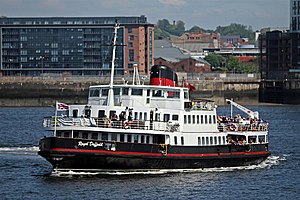MV Royal Daffodil

MV Royal Daffodil on the River Mersey in May 2012
|
|
| History | |
|---|---|
| Name: |
|
| Owner: | Mersey Ferries |
| Operator: |
|
| Port of registry: | 1962 onwards: Liverpool, |
| Builder: | Cammell Laird, United Kingdom |
| Laid down: | April 1961 |
| Launched: | November 1961 |
| Christened: | November 1961 |
| Completed: | March 1962 |
| Maiden voyage: | April 1962 |
| In service: | April 1962 - December 2012 |
| Out of service: | January 2013 |
| Identification: | MHWB2 |
| Fate: | Out of service |
| Status: | Laid up |
| General characteristics | |
| Class and type: | Class IV with seasonal class III |
| Tonnage: | 751 GT |
| Length: | 44m |
| Beam: | 12m |
| Draught: | 3.5m |
| Decks: | 4 - bridge deck, promenade deck, main deck, lower deck |
| Installed power: | 2 x Cummins - Wärtsilä 170 diesel engines |
| Speed: | 12–15 knots (22–28 km/h; 14–17 mph) |
| Capacity: | 860 on ferry duties, 370 on cruises |
| Crew: | captain, mate, engineer, seapersons x 2, catering assistant |
The Royal Daffodil is a ferry based on the River Mersey, England. She is currently laid up due to cost cutting measures. From launch until a major refit in 1998, she was named MV Overchurch, she began service for Birkenhead Corporation Ferries in 1962, and was withdrawn from regular service by Mersey Ferries in 1990 where she saw minimal active work until 1999, when she was extensively refurbished. Despite her extensive re-build, the ship still retains a similar profile. Royal Daffodil was withdrawn from regular service in December 2012 and returned to the ferries berth at Duke St, Birkenhead. The ship has remained idle since her dry docking and survey in January 2013 and is currently laid up.
The vessel was built for Birkenhead Corporation in 1962 at Cammell Laird, Birkenhead. She was named after one of the town's post-war overspill housing developments.
The ferry was the first of the fleet to be of all-welded construction and she is currently the last Mersey Ferry to be built. The Overchurch was popular with its Captains and Mates as its navigation bridge spanned the whole ship, rather than having a wheelhouse and side cabs such as Mountwood and Woodchurch used. A model of the ship by builders Cammel Laird is on display in the Williamson Gallery in Birkenhead. The wheelhouse was spacious with a single binnacle and brass wheel. Most of the ships control instruments were fitted into specially built stand alone units, including the telegraph heads. Unlike Mountwood and Woodchurch, there was no central set of telegraphs next to the helm, so the crew were required to move to either of the bridge wings to control the engines. Her bridge was modern, unlike the compact and relatively cluttered bridges on the Overchurch's two near sisters, where most of the instruments were attached to the bulkheads. It was a handsome vessel, with clean and smooth lines and a stout funnel. Her original livery was Birkenhead's orange and black, with a flame red band above the rubbing strake.
The Overchurch contained identical engines to Mountwood and Woodchuch, however, with a gross tonnage of 468, the ship was slightly heavier than its two near sisters and was therefore a little slower when running against a strong tide. The original plan was to have a third ferry built to the designs of Mountwood and Woodchurch, however, Birkenhead Corporation decided to design a completely new vessel.
...
Wikipedia
